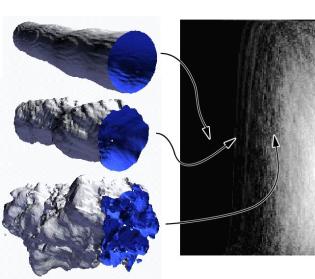

Highlights
- The amount of data from scientific and engineering simulations is so large that the overwhelming percentage of it is never inspected.
- We produce tools that suggest where and when to look to find interesting phenomena in the data, based on what could be called “computational topology.”
- We are working toward a system that allows remote inspection of large simulation data sets.
The Challenge
Progress in many areas of science and engineering relies on our ability to analyze vast amounts of four-dimensional (4D) data, which are produced to represent the evolution through time of variables such as temperature, pressure, and flow velocity that are measured or computed on a dense set of sample points in space. We include several small examples of jet streams, combustion processes, and pollution studies; large examples can run to hundreds of gigabytes.The visual exploration of such data is a fundamental tool for engineers, scientists, and educators. It is a complicated task, however, because the data as produced is large, remote, multi-dimensional, and generally featureless. Visualization is time-consuming, because it entails downloading, extracting, and rendering lower-dimensional subsets.
The Approach
Based on recent and projected results in geometric data structures, we are developing a client/server-based tool for visual analysis of iso-surfaces and cross-sections in remotely-located, time-varying volume data. On the client side, we partition the data display into a 3D viewing volume for iso-surfaces and cross-sections and a 2D control plane in which each point corresponds to a particular iso-surface or cross-section. On the server side, we are developing new geometric data structure based on an unstructured mesh of 4-simplices to support remote storage and real-time interaction with the data.In brief, the scenario for operation is the following: The server will take the simulation data, simplify it, and compute the simplicial mesh, and annotations for the client's control plane that can guide user exploration of the data. The user will set viewing parameters by selecting points on the control plane, and the server will respond with the data needed to display a cross-section or iso-surface. If the user moves slowly across the control plane, following some feature of interest such as a pressure wave at different times, then the server will simply send updates to the iso-surface. If the user stops, then the server will continue to send updates to progressively refine the accuracy of the client's display. To make this scenario possible, research is required on the server (data representation, simplification, and compression), clients (computation and display of topological and geometric features, progressive refinement), and users (effective control plane annotations, interaction rates) for this system.
We also provide guidance for where and when a user should inspect. For example, the control plane can be colored to indicate global properties of the possible views of the data; we color by number of components in the accompanying pictures. Large numbers of components, corresponding to lighter regions, indicate turbulence or other unstable phenomena in these examples.
The points of the control plane correspond to iso-surfaces for this supersonic jet. A pulsed jet data set, with the number of components on the control plane.
Combustion data at different times and density, colored by propagation velocity. Oil displacing water in soil in a pollution study; the first control plane, for water, indicates placed to look as water is forced out. Project Leaders
- Jack Snoeyink, Professor
- Lutz Kettner, Postdoctoral Researcher
Other InvestigatorsJarek Rossignac, Professor, Georgia Tech
Graduate Research StudentsAjith Mascarenhas, UNC Chapel Hill
Research Sponsors
Application submitted to NSF ITR in Jan 2001Selected Publications
For More Information
Jack Snoeyink
Department of Computer Science
University of North Carolina at Chapel Hill
CB#3175, Sitterson Hall
Chapel Hill, NC 27599-3175
Phone: (919) 962-1969
Fax:(919) 962-1799
Web: www.cs.unc.edu/~snoeyink
